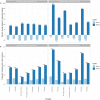Thrice out of Asia and the adaptive radiation of the western honey bee
- PMID: 34860547
- PMCID: PMC8641936
- DOI: 10.1126/sciadv.abj2151
Thrice out of Asia and the adaptive radiation of the western honey bee
Abstract
The origin of the western honey bee Apis mellifera has been intensely debated. Addressing this knowledge gap is essential for understanding the evolution and genetics of one of the world’s most important pollinators. By analyzing 251 genomes from 18 native subspecies, we found support for an Asian origin of honey bees with at least three expansions leading to African and European lineages. The adaptive radiation of honey bees involved selection on a few genomic “hotspots.” We found 145 genes with independent signatures of selection across all bee lineages, and these genes were highly associated with worker traits. Our results indicate that a core set of genes associated with worker and colony traits facilitated the adaptive radiation of honey bees across their vast distribution.
Figures




References
-
- Arias M. C., Sheppard W. S., Phylogenetic relationships of honey bees (Hymenoptera: Apinae: Apini) inferred from nuclear and mitochondrial DNA sequence data. Mol. Phylogenet. Evol. 37, 25–35 (2005). - PubMed
-
- Lo N., Gloag R. S., Anderson D. L., Oldroyd B. P., A molecular phylogeny of the genus Apis suggests that the Giant Honey Bee of the Philippines, A. breviligula Maa, and the Plains Honey Bee of southern India, A. indica Fabricius, are valid species. Syst. Entomol. 35, 226–233 (2010).
-
- Raffiudin R., Crozier R. H., Phylogenetic analysis of honey bee behavioral evolution. Mol. Phylogenet. Evol. 43, 543–552 (2007). - PubMed
-
- Dogantzis K. A., Zayed A., Recent advances in population and quantitative genomics of honey bees. Curr. Opin. Insect Sci. 31, 93–98 (2019). - PubMed
-
- F. Ruttner, Biogeography and Taxonomy of Honeybees (Springer Berlin Heidelberg, 1988).
LinkOut - more resources
Full Text Sources
Miscellaneous

